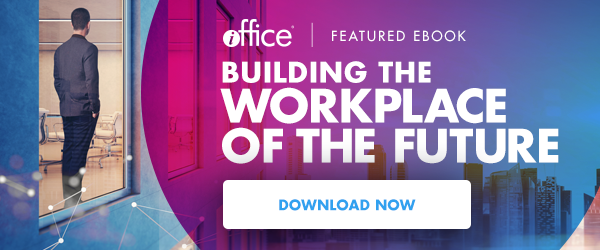What Will Your Workplace Look Like in 2020?


We’ve talked a lot about the kinds of workplace trends forward-thinking organizations are embracing.
In general, we’re seeing a shift away from cubicles and toward more collaborative environments like activity-based working, coworking and neighborhood work environments.
That’s where we are right now—but what will workplaces look like five or 10 years from now?
It’s a question that keeps many workplace leaders up at night. And there’s perhaps no one better to answer it than Kay Sargent. Sargent is a senior principal and director of HOK’s WorkPlace practice, as well as the co-founder of the Workplace Evolutionaries community at IFMA.
She recently co-hosted a webinar, The Big Shift: The Workplace Trends Impacting Your Organization’s Workforce, with our own Mike Petrusky. It’s a fascinating discussion you’ll be glad you listened to over your next lunch break. In the meantime, here are three future workplace trends you’re sure to hear more about in the near future.
3 Future Workplace Trends Coming In 2020 And Beyond
1. The ‘Garage-ification’ of the Workplace
We’ve all heard the stories of billion-dollar companies that started in someone’s garage. There’s Apple. There’s Amazon. Google. Microsoft and Hewlett-Packard. Even Disney got its start with Walt and Roy creating part of the original Alice in Wonderland animation series in their uncle’s garage in 1923.
In a world where it’s all about speed to innovation, Sargent said more workplaces are being designed to evoke “that scrappy entrepreneur spirit.”
Also referred to as Maker Environments, Mobile Occupants (MEMO) spaces or “agile program space”, it comes down to creating spaces that foster creativity and make all employees feel like they’re part of the process.
IBM even has its own Cloud Garage, a collaborative environment and consulting service where IBM experts work with clients to rapidly design, develop, test and operate applications on the IBM Cloud. This results in faster speed to market, higher quality, lower costs and better scalability.
“The Garage is really unique in that we’re bringing together not only our technical skills and tools, but we’re also incorporating and transforming the culture of our clients,” said Eileen Lowry of the IBM Blockchain Lab & Garage. “They’re actually understanding how to do agile development.”
Check out this video to learn more about how it works.
2. An Emphasis on Human Metrics Versus Space Metrics
The facility management industry tends to put a lot of emphasis on space metrics—and space utilization is certainly important—but Sargent said it isn’t what’s keeping most CEOs up at night.
They’re more concerned about people metrics—in other words, attracting and retaining new talent.
A large organization spends about 80 percent of its operational costs on its people, according to data from HOK, which can be five to 10 times the cost of its facilities, Sargent pointed out.
“We talk a lot about the workplace of the future, but if we are truly designing for people, the bigger question we should be asking is who is the worker of the future,” Sargent said.
The takeaway? Leaders need to think about how the physical space, workplace technology and policies and procedures work together to impact the employee experience.
They need to focus on creating a high-touch work environment—one that emphasizes relationships and engagement—rather than a primarily high-tech environment. Workplace technology is important, but only to the extent that it empowers employees.
| Past | Present & Future |
| Workplace of the Future | Worker of the Future |
| Space-centric metrics |
Human-centric metrics |
| Environmental sustainability | Human sustainability (sitting too much) |
| I.Q. | E.Q. |
| Man (the art of the job/judgment) | Computers (science of the job/computation) |
| High tech | High touch |
| Place | User experience |
| Facility Manager | Community Manager |
| Silos | Space fusion |
| Own and control | Shared economy |
| Hierarchical | Team oriented |
The Workplace of the Past, Present & Future
3. Immersive Environments
Over the past 30 years, workplace design trends have evolved from private offices and cubicles to open spaces, then into a blend of both.
Immersive workplace environments pull the best lessons learned from all these workspaces and tailors them to meet a company’s specific needs. Rather than focusing on trends, they focus on outcomes.
Design firm Knoll Research uses the term “immersive planning” to describe the approach to this new environment. It compares the workplace to a town square, with elements of residential and hospitality design, smaller individual workspaces and more shared spaces and amenities. It is “as fluid as teams themselves” and defined by employees’ actions rather than their job function. The immersive workplace has three main characteristics on outcomes.
- Improvisational – A spontaneous, user-defined atmosphere that allows for continuous movement and purposeful transitions, with blurred boundaries
- Communal – A connected, people-focused environment
- Dimensional – A workplace created to be both visually and tactually diverse, with multiple textures and materials
The immersive environment is expected to become more common as networks replace hierarchies, more work happens in groups and contractors and temporary workers make up a greater percentage of the workforce.
Sargent said while conversations about the “workplace of the future” can be easily dominated by conversations about technology, we should never lose sight of the people at the center of every workplace.
“Science fiction has always gotten the technology portion of it right,” she said. “What they have failed miserably at is social change and the human aspect. We need to remember specifically in our industry that we are designing for people.”
